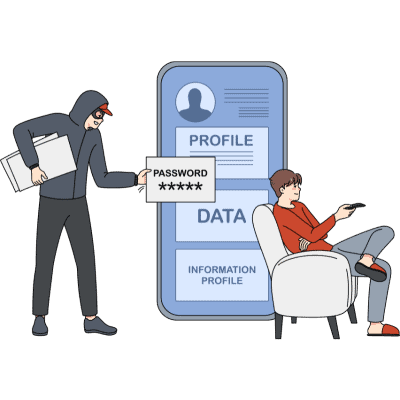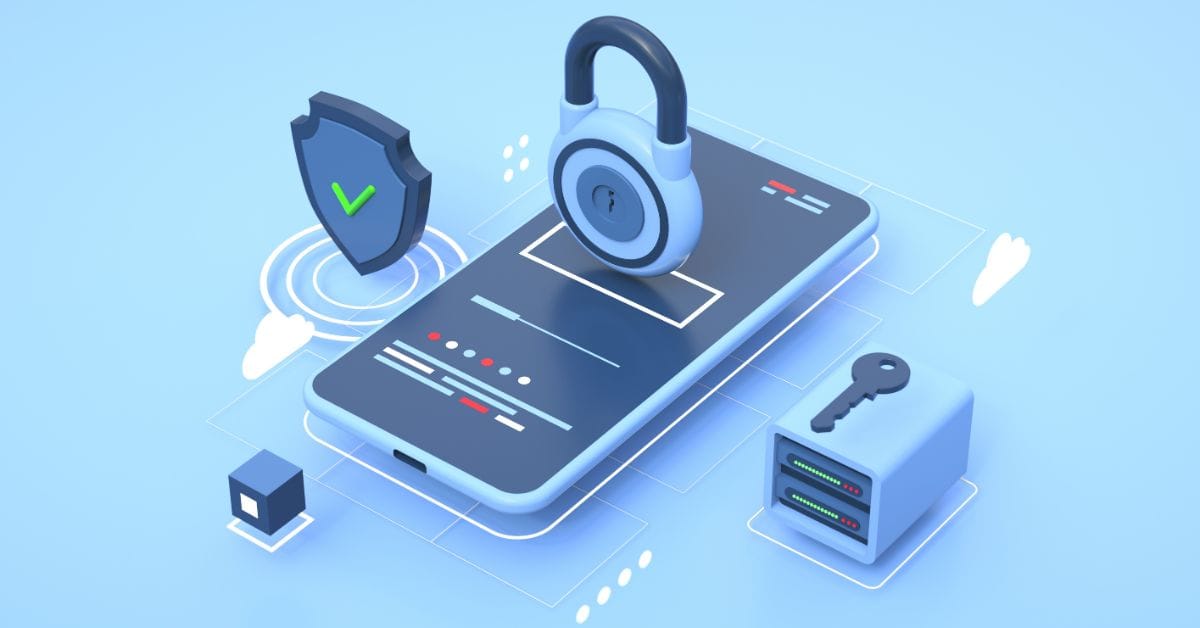Looking for your plus one on dating apps is fun, especially when you land on a profile of someone who ticks all of the boxes, and you swipe right. The rush is real! But while we love the endorphins you get at a potential romance on the horizon, dating app safety is incredibly important.
In the big wide world of digital dating, where you land yourself a hot date with just a flick of your thumb, knowing how to protect yourself is a must. It doesn’t matter if you’re a swiper who’s been around the dating app block or trying it out for the first time; a few practical and easy safety tips will go a long way in making sure your online dating experience is both fun and secure.
While they were once considered to be a little taboo, they are now fully mainstream—dating apps are now the norm when it comes to looking for love and have surged in popularity in the last five years. Did you know that over 40 percent of singles have used a dating app at some point? It’s not actually surprising, given how easy they make meeting potential romantic partners. But this great convenience comes along with some potential risks—possibly serious ones. From catfishing to data breaches, it’s super important to be aware of the darker side of online dating to keep yourself and your sensitive info safe!
We’re going to teach you all about dating app safety and what you need to know before swiping right, so you are aware of and can spot any risks.
Understanding the Risks
Obviously, the advent of dating apps changed how we meet new people—it’s so much easier to find and connect with potential partners and less annoying than a relative uttering these dreaded words: “I have someone you should meet!” However, this convenience is accompanied by some dangers that users need to be aware of to stay safe. From fake profiles to the more sophisticated scams, understanding these risks will help you navigate the world of online dating with confidence.
But before we get into specifics, we need to talk about the one danger you’re most likely to encounter on a dating app: romance scams.
What Are Romance Scams?
Romance scams are, in our opinion, the most insidious kind of scam, and they’re particularly rampant on dating apps. What happens in these cases is a scammer makes a fake profile and woos an unsuspecting victim, all with the goal of eventually swindling them out of money or personal information. It’s super important to be aware of these scams because they can happen to anyone, and the emotional and financial toll can be devastating.
A romance scam usually starts with a scammer setting up a fake profile on a dating app using stolen photos and fake details to appear attractive and trustworthy. The scammer then engages with their targets, sometimes over weeks or even months if they are playing the long game, to build a genuine-seeming relationship. This period of relationship-building is crucial, as it establishes trust and emotional connection.
Once the scammer feels they have gained enough trust, they will make up an emergency or financial crisis, like emergency surgery, legal trouble, or travel expenses to come visit. Then comes the money grab—they’ll ask their target for funds. It could be in the form of wire transfers, gift cards, or cryptocurrencies, which are hard to trace. If the victim complies, the scammer will continue to come up with new crises to get more money until the victim either runs out of funds or realizes they’ve been tricked.
These scams prey on people’s emotions, making it difficult for victims to recognize the deceit. The emotional investment can make the financial loss even more painful. The betrayal involved can have a lasting emotional and psychological impact, leading to issues with trust and self-esteem in future romantic relationships.
Types of Risks
Traversing the online dating world isn’t without its bumps, that’s for sure. Yes, dating apps provide a platform for new romance connections, but they also expose users to different perils. Here’s a rundown of the common threats you could encounter while swiping right:

Catfishing
Catfishing is when someone makes a fake dating profile to deceive others. The perpetrator uses someone else’s photos and fabricates personal details to lure unsuspecting users into a “relationship.” These counterfeit personas will avoid video calls or in-person meetings to keep the deception going.

Scams
Online dating scams come in many forms, but the goal is usually financial gain. Scammers will concoct elaborate and wild stories to gain your trust and sympathy—ultimately asking for money for fake emergencies or investments. They usually claim to be in professions that would explain their inability to meet in person, like being in the military or working overseas.

Data Breaches
Dating apps collect a massive amount of personal data and info, making them super attractive targets for hackers. A data breach can expose sensitive information like your name, location, and even your financial details if you’ve paid for a premium plan on a dating app. All of this information can be used for identity theft or sold on the dark web.

Sextortion
Sextortion is when scammers convince victims to share explicit photos and then threaten to release these images unless they receive payment. Reports of sextortion have seen an alarming rise in the last few years, with young adults being the most frequent targets.

Phishing
Phishing scams entail sending fake emails or messages that appear to be from a legit dating app, asking for login details or financial info. These messages may lead to identity theft or economic loss.

Harassment and Stalking
Unfortunately, some users can be harassed or stalked by people they meet online with unwanted messages, threats, or even being followed in real life.
Real-life Examples and Statistics
The rise in online dating scams is actually staggering—in 2022, nearly 70,000 people reported romance scams to the Federal Trade Commission (FTC), with losses totaling $1.3 billion. The median individual loss was $4,400, a huge uptick from previous years.
Debbie’s StoryOne of the more heartbreaking stories is that of Debbie, who was scammed out of over $100,000 by a man who posed as a successful entrepreneur. He built trust over several months before convincing her to invest in his fake business. By the time she realized it was a scam, she had lost her life savings.
Richard’s StoryRichard, another victim, was manipulated into sending $50,000 to a supposed girlfriend who claimed she needed money for medical expenses. It turned out she was part of a larger network of scammers, leaving Richard both emotionally devastated and in financial ruin.
The Tinder SwindlerY’all are probably familiar with the high-profile case of the “Tinder Swindler,” but if you aren’t, a man named Simon Leviev used Tinder to defraud multiple women out of large sums of money. He built trust by presenting a lavish lifestyle and then lying about fake emergencies that required financial help. His victims ended up in severe debt, and their stories were told in a Netflix documentary of the same name.
Anna’s StoryAnna shared her story of being scammed by a man she met online who claimed to be in the military. After months of building a relationship, he asked her for money to help with supposed legal fees to leave his post and be with her. She lost $20,000 before realizing it was a scam.
Emily’s StoryEmily fell for a scammer who claimed to need money for emergency surgery—after sending thousands of dollars, she discovered that all his photos were stolen from a real doctor’s profile, and he had scammed multiple women in a similar way.
Being aware of these threats and taking precautions can reduce your chances of falling victim to a scam. Always verify dating profiles, avoid sharing personal or financial info too soon, and listen to your instincts. If something feels off, it’s better to err on the side of caution.
Choosing a Safe Dating App
With these potential perils in mind, how are you supposed to choose a safe dating app? Well, some are safer than others—when trying to decide, you should make sure they offer certain features!
Main Features to Look for in a Secure Dating App
When deciding on a dating app, prioritize the following security features:
- Profile Verification: Look for apps that offer verification processes, such as linking profiles to social media accounts or requiring a phone number. Verified profiles help reduce the risk of encountering fake accounts or scammers.
- Encryption: Make sure that the app uses end-to-end encryption for messages. This means only you and the person you’re communicating with can read the messages, protecting your conversations.
- Privacy Controls: Check for strong privacy settings that allow you to control who sees your profile and personal information. The ability to hide your profile from search engines and non-matched users is a plus.
- Reporting and Blocking: A secure app should have easy-to-use features for reporting and blocking suspicious or abusive users. This helps maintain a safer community by quickly addressing harmful behavior.
- Background Checks: Some dating apps conduct background checks on users to weed out those with a history of criminal activity. While not foolproof, this does add more security.
- Data Protection Policies: Review the app’s data protection policies to understand how your information is stored and shared. Look for apps that are transparent about their data practices and comply with regulations.
Comparison of Privacy and Security Features in Popular Dating Apps
When choosing a dating app, it’s important to understand the privacy and security features they offer. Here’s a comparison of some of the most popular dating apps:

- Profile Verification: Tinder offers photo verification to help users confirm that their profile pictures are real. This helps to cut back on the number of fake profiles on the platform.
- Encryption: Tinder uses standard encryption for its messaging feature but does not provide end-to-end encryption.
- Privacy Controls: Users can control who sees their profile through settings like “Hide from Tinder’s Top Picks” and “Hide my profile from search engines.”
- Reporting and Blocking: The app has straightforward options for reporting and blocking users, increasing user safety.
- Data Protection Policies: Tinder’s privacy policy outlines how it collects, uses, and shares personal data. It adheres to GDPR regulations for European users.

- Profile Verification: eharmony requires users to complete a detailed questionnaire, which helps in creating real profiles. However, it does not have a specific photo verification process.
- Encryption: The app uses encryption for data transmission, but end-to-end encryption for messages is not specified in their safety section or FAQs.
- Privacy Controls: eharmony allows users to hide their profiles and control who can see their photos and personal information.
- Reporting and Blocking: Users can report and block profiles easily, which means a safer environment.
- Data Protection Policies: eharmony follows stringent data protection policies and complies with GDPR and other privacy laws.

- Profile Verification: Elite Singles uses a thorough registration process that includes a personality test, reducing the likelihood of fake profiles.
- Encryption: The app uses SSL encryption for secure data transmission.
- Privacy Controls: Users have control over their privacy settings, including who can see their profile and photos.
- Reporting and Blocking: Elite Singles provides options for reporting and blocking suspicious users.
- Data Protection Policies: The app has comprehensive data protection policies and complies with GDPR standards.

- Profile Verification: Bumble offers photo verification to ensure users are real, adding more security.
- Encryption: Bumble employs standard encryption for its messaging but does not specify end-to-end encryption.
- Privacy Controls: The app allows users to hide their profiles from specific people and control who sees their info.
- Reporting and Blocking: Users can report and block other users easily, promising a safer user environment.
- Data Protection Policies: Bumble is transparent about its data practices and complies with GDPR regulations.

- Profile Verification: Hinge uses phone number verification and links profiles to Facebook or other social media accounts for authenticity.
- Encryption: Hinge uses encryption for data transmission but does not provide end-to-end encryption for messages.
- Privacy Controls: Users can control who sees their profile and hide their profile from non-matched users.
- Reporting and Blocking: Hinge offers easy-to-use reporting and blocking features to deal with suspicious or abusive behavior.
- Data Protection Policies: Hinge follows strict data protection policies and adheres to GDPR for European users.
Setting Up Your Profile Safely
Creating a safe and appealing online dating profile is so important for a positive and secure experience! With the right practices, you can protect your personal info while still showing off your one-of-a-kind personality. Here’s how you can set up your profile safely and for dating success.
Best Practices for Profile Creation
When setting up your dating profile, focus on safety and being real. The following are some good tips to consider:
- Use a Unique Username: Avoid using your real name or any username that you use on other social media platforms. This helps protect your identity and makes it harder for others to find you outside of the dating app.
- Profile Pictures: Choose clear, recent photos that represent you well, but avoid using pictures that you’ve posted elsewhere online. This prevents reverse image searches that could lead to your other social media profiles.
- Verification: Opt for platforms that offer verification processes. Verified profiles are generally considered more trustworthy, and participating in these means you appear to others as a genuine user.
- Strong Privacy Settings: Adjust your privacy settings to control who can see your profile and personal information. Limit visibility to only those you’ve matched with, and avoid connecting your dating profile to other social media accounts.
- Keep Conversations within the App: Use the app’s messaging system instead of moving to text or other communication platforms immediately. This keeps your conversations secure and makes it easier to block or report suspicious users if necessary.
What Info to Include and Exclude
Now, when filling out your dating profile, it’s important to hit the right balance between being informative and maintaining your privacy. Below is a guide on what to include and what to leave out:
What to Include
- Basic Information: Share general details like your first name, age, and a few interests. This will give potential matches a glimpse into who you are without giving away too much personal information.
- Hobbies and Interests: Talk about your hobbies, interests, and what you enjoy doing in your free time. This can attract matches with the same interests and provide natural conversation starters.
- What You’re Looking For: Be clear about what you’re seeking in a partner and a relationship. This helps filter out those who might not match up with your dating goals from the start.
- Personality Traits: Describe your personality traits and what makes you unique. This gives potential matches a better sense of who you are and what you’re like.
What to Exclude
- Full Name and Contact Information: Never ever include your full name, home address, phone number, or work details—this information can be used to track you down outside the dating app.
- Sensitive Personal Information: Do NOT share your social security number, financial information, or details about your daily routine. This helps protect you from identity theft and other forms of fraud.
- Exact Locations: Don’t share specific locations you frequent, such as your workplace or favorite hangouts. General descriptions are fine, but specifics can compromise your safety.
- Explicit Photos: Never share explicit photos or videos. These can be used for blackmail or harassment if they fall into the wrong hands.
- Linked Social Media Accounts: Don’t link your dating profile to your social media accounts. This can make it easier for someone to gather more info about you than you intended to share!
Managing Privacy Settings
When it comes to online dating, safeguarding your privacy is as important as finding a compatible match. With so many dating apps available, you need to know how to manage your privacy settings effectively. This not only protects your personal information but also improves your overall dating experience by reducing the risk of encountering scammers or unwanted attention.
Overview of Necessary Privacy Settings
Privacy settings in dating apps allow you to control who can see your profile, what information is shared, and how your data is used. The main privacy settings to look out for include the following:
- Profile Visibility: You can control who can view your profile. Some apps offer options to hide your profile from users who haven’t matched with you.
- Location Sharing: Manage how your location data is used and shared. You can choose to disable location tracking when not actively using the app.
- Blocking and Reporting: Make sure the app has easy-to-use features for blocking and reporting suspicious or inappropriate behavior.
- Data Usage: Review the app’s data usage policies to understand how your information is stored, shared, and protected.
- Two-Factor Authentication: Adds another layer of security by requiring a second form of identification when logging in.
Step-by-Step Guide on Adjusting Settings for Popular Apps
Here’s how you can adjust the privacy settings on Tinder, eharmony, Elite Singles, Bumble, and Hinge.
Tinder
| Setting | Steps |
|---|---|
Profile Visibility | • Open the Tinder app and go to your profile. |
Location Sharing | • In the settings menu, find “Location Services.” |
Blocking and Reporting | • Open the profile of the user you want to block or report. |
Data Usage | • Visit Tinder’s privacy policy page from the app settings to understand how your data is used. |
Two-Factor Authentication | • Enable two-factor authentication in the account settings for more security. |
eharmony
| Setting | Steps |
|---|---|
Profile Visibility | • Log in to your account on the eharmony website or app. |
Location Sharing | • eharmony uses your general location for match suggestions. To manage this, go to the location settings in your profile. |
Blocking and Reporting | • Open the profile of the user you want to block or report. |
Data Usage | • Review eharmony’s privacy policy from the settings menu to see how your data is handled. |
Two-Factor Authentication | • As of now, eharmony doesn’t offer two-factor authentication, but using a strong password and regularly updating it is highly recommended. |
Elite Singles
| Setting | Steps |
|---|---|
Profile Visibility | • Log in to EliteSingles and navigate to your account settings. |
Location Sharing | • Manage your location settings under the profile settings to control how your location is shared. |
Blocking and Reporting | • From the user’s profile, use the “Block” or “Report” button to manage unwanted interactions. |
Data Usage | • Check Elite Singles’ data usage policies directly from the app’s settings. |
Two-Factor Authentication | • Elite Singles currently does not offer two-factor authentication. Use strong, unique passwords for your account. |
Bumble
| Setting | Steps |
|---|---|
Profile Visibility | • Open Bumble and go to your profile. |
Location Sharing | • Bumble updates your location only when the app is active. To control this, adjust location permissions in your device settings. |
Blocking and Reporting | • Tap on the user’s profile, click on the three dots, and select “Block” or “Report.” |
Data Usage | • Access Bumble’s privacy policy from the settings to see how your data is used. |
Two-Factor Authentication | • Enable two-factor authentication through Bumble’s security settings for better protection. |
Hinge
| Setting | Steps |
|---|---|
Profile Visibility | • Open Hinge and go to your profile settings. |
Location Sharing | • Hinge uses your location to find matches. You can manage this in the settings by adjusting your device’s location permissions. |
Blocking and Reporting | • Go to the user’s profile, click on the three dots, and select “Block” or “Report.” |
Data Usage | • Review Hinge’s data policies from the settings menu to understand how your information is managed. |
Two-Factor Authentication | • Hinge does not currently offer two-factor authentication, so make sure your password is strong and unique so it can’t be easily guessed. |
Safe Communication Practices
Online dating is now one of the most popular and common ways to meet new people. While yes, it is super convenient and has a big pool of potential matches, it also comes with a particular set of risks. That means protecting your personal info and maintaining your safety is mainly up to you! Read to see how you can communicate safely on dating apps and the shady stuff to watch out for.
Tips for Secure Messaging
Communicating safely on dating apps involves more than just engaging in pleasant conversation. It requires a conscious effort to protect your personal information and stay alert to potential risks. Here are the best tips to keep your messages secure:
- Keep Conversations within the App: Always use the app’s messaging system for communication. This allows the platform to monitor and address any suspicious activity. Avoid moving to other communication channels, like email or phone, until you’ve established trust.
- Avoid Sharing Personal Information: Do not share sensitive information such as your home address, workplace, phone number, or financial details. Even seemingly harmless details can be pieced together to compromise your privacy.
- Use Different Photos: Avoid using the same photos for your dating profile that you use on social media. This prevents potential matches from reverse image searching to find your social media accounts, thus maintaining your privacy.
- Enable Two-Factor Authentication: If the app offers two-factor authentication, use it. This adds another level of security by requiring a second form of identification when logging in.
- Be Cautious with Links and Attachments: Do not click on links or download attachments from people you don’t know. These could be phishing attempts or contain malware.
Identifying and Avoiding Suspicious Behavior
Even with the best practices in place, you could still connect with people who have malicious intent. Recognizing the signs of suspicious behavior can help you avoid potential scams!
- Watch for Red Flags: Be alert to common scam tactics such as requests for financial assistance, stories that seem too good to be true, or someone pushing to move the conversation off the app quickly. Other red flags include profiles with few details, overly complimentary messages early on, and inconsistent information.
- Verify Identities: Before meeting in person or sharing more personal information, consider having a video call. This helps confirm that the person you’re talking to matches their profile and isn’t using someone else’s photos.
- Trust Your Instincts: If something feels off, trust your gut. It’s better to be safe and cautious than to regret ignoring warning signs. Report any suspicious behavior to the app’s administrators ASAP!
- Avoid Quick Disclosures: Scammers will try to build an emotional connection quickly to gain your trust. Be wary of anyone who shares very personal details early on or pressures you to do the same.
- Use App Features: Utilize the app’s features to block and report users who exhibit suspicious behavior. This not only protects you but also helps maintain a safer environment for other users.
Meeting in Person: Safety Precautions
Meeting someone in person after connecting online is exciting, but you have to take precautions to stay safe. Even if your chats have been amazing, you never truly know someone until you’ve met them face-to-face. By following some basic safety steps, you can protect yourself!
Steps to Take Before Meeting Someone in Person
Before meeting up with someone from a dating app, there are several precautions you should consider. These steps help to make sure that your first meeting is safe and sound:
- Verify Their Identity: Before meeting up, make sure the person you’re talking to is who they claim to be. This can be done through video calls, checking their social media profiles, or doing a quick online search with a tool like Social Catfish. Many dating platforms now offer video chat features to help confirm identities.
- Plan the Meeting in a Public Place: Always choose a public location for your first few meetings. Coffee shops, restaurants, and other busy places are ideal as they provide a safe environment and easy access to help if needed. Don’t meet in secluded areas or private homes for the first meetings.
- Tell Friends or Family: Let someone you trust know where you’re going, who you’re meeting, and when you expect to be back. Share details of your date, including their name and contact information. You can also share your location with them—-drop a pin.
- Have Your Own Transportation: Drive yourself or use a ride-share service to get to and from the date. This ensures that you can leave whenever you want without relying on your date for a ride. It’s important to maintain control over your transportation arrangements.
- Set Boundaries and Expectations: Be clear about your boundaries and what you’re comfy with. Communicate these boundaries to your date, and don’t be afraid to enforce them. It’s okay to leave if you feel uncomfortable at any time during the date.
Tips for Safe First Dates
If and when the time comes to meet your online match in person, there are a few things to keep in mind to make sure your first date goes safely and without a hitch:
- Keep It Casual and Short: For a first date, do something short and casual, like grabbing a drink or taking a walk. This allows you to gauge your comfort level without committing to a lengthy time period.
- Stay Sober: Avoid consuming too much alcohol or any substances that could impair your judgment. Staying sober helps you stay alert and aware of your surroundings, which is crucial for your safety.
- Observe Their Behavior: Pay attention to your date’s behavior and body language. Red flags include being overly intimate or romantic too soon, pressuring you for personal information, or refusing to meet in public places. Trust your gut if anything feels off.
- Prepare an Exit Strategy: Have a plan in place in case you need to leave abruptly. Arrange with a friend or family member to call or text you at a certain time to check-in. You can also establish a code word or signal that indicates you need assistance.
- Limit Personal Information Sharing: Avoid sharing too much personal information on the first few dates. Keep details like your home address, full name, and workplace private until you feel comfortable and trust the person more.
- Use Personal Safety Apps: Consider using personal safety apps that can quickly alert friends or authorities if you feel unsafe. Apps like Arlo Safe offer one-tap emergency services and location sharing, providing additional security.
Meeting someone in person after connecting online can be a wonderful experience if done safely. By taking the right precautions, like verifying identities, meeting in public places, telling people you trust about your date plans, and having an exit strategy, you can protect yourself when getting to know someone new!
Recognizing and Reporting Suspicious Activity
Recognizing and reporting suspicious activity is crucial to protect yourself and others from potential scams and harmful behavior. Here’s how to spot red flags and report suspicious activities on Tinder, eharmony, Elite Singles, Bumble, and Hinge.
How to Spot Red Flags
Being able to sniff out suspicious behavior is your BFF and the first line of defense against online scams and frauds. Here are a few of the most common red flags to watch out for:
- Rapid Romance Development: If someone professes love or strong affection very quickly, like within days or weeks, it’s a major red flag. Genuine relationships take time to build.
- Inconsistencies in Their Story: Pay attention to personal stories or details that don’t add up. Scammers often provide inconsistent or evasive answers to questions about themselves.
- Avoidance of Face-to-Face Meetings: If someone consistently finds excuses to avoid meeting in person or video chatting, they are not who they say they are.
- Requests for Money: Be extremely cautious if someone asks for financial help, especially through unconventional means like cryptocurrency, wire transfers, or gift cards.
- Secrecy and Isolation: If they encourage you to keep your relationship a secret or become upset when you discuss them with friends or family, it’s a tactic to isolate and manipulate you.
- Overly Flattering and Sympathetic: Excessive compliments and sympathy, especially combined with sob stories, are often used to create emotional dependence and trust.
Reporting Mechanisms on Various Dating Apps
All reputable dating apps have built-in features to report suspicious activity—here’s how to do it on the dating apps we’ve explored!
Tinder
| Feature | Steps |
|---|---|
Reporting a User | • Go to the profile of the person you want to report. |
Blocking a User | • Similar to reporting, tap the three dots on the user’s profile. |
eharmony
| Feature | Steps |
|---|---|
Reporting a User | • Access the user’s profile. |
Blocking a User | • Go to the user’s profile and select “Block” to prevent them from contacting you. |
Elite Singles
| Feature | Steps |
|---|---|
Reporting a User | • Go to the dating profile you want to report. |
Blocking a User | • Use the same menu to select “Block” and confirm your action. |
Bumble
| Feature | Steps |
|---|---|
Reporting a User | • Open the conversation with the user. |
Blocking a User | • Same steps as reporting: tap the three dots and select “Block.” |
Hinge
| Feature | Steps |
|---|---|
Reporting a User | • From the profile page or messaging window, tap the three dots. |
Blocking a User | • Use the same menu to choose “Block” and confirm. |
Protecting Your Personal Data
In the age of digital connectivity, protecting your personal data online is more critical than ever. With the rise of online dating, your personal info can easily fall into the wrong hands if proper precautions aren’t taken. Implementing secure online behavior and using tools like VPNs is worth it when it comes to increasing your online privacy and security!
Secure Online Behavior Tips
Adopting secure online habits is the first step in safeguarding your personal data on dating apps. Here are the essentials:
Use Strong, Unique Passwords:
- Create complex passwords that include a mix of letters, numbers, and special characters. Avoid using easily guessable information such as birthdays or common words.
- To minimize risk, use a different password for each of your online accounts. Consider using a password manager to securely keep track of your credentials.
Enable Two-Factor Authentication (2FA):
- Two-factor authentication adds increased security by requiring a second form of verification, such as a code sent to your phone, in addition to your password. This makes it more difficult for unauthorized users to access your accounts.

Be Wary of Phishing Scams:
- Be cautious of emails, messages, or websites that ask for personal information. Phishing scams often disguise themselves as legit organizations to trick you into revealing sensitive data.
- Verify the sender’s information and avoid clicking on suspicious links or downloading attachments from unknown sources.
Limit Personal Information Sharing:
- Avoid oversharing personal details on dating apps and other online platforms. Cybercriminals can use information like your home address, phone number, and daily routines to target you.
- Regularly review your privacy settings on dating apps to control who can see your profile and personal information.
Keep Software Updated:
- You should regularly update your operating system, browsers, and software applications. Updates often include security patches that protect against vulnerabilities and threats.
Use Secure Connections:
- Use secure, encrypted connections (HTTPS) whenever you can when browsing websites. This helps protect your data from being intercepted by cybercriminals.
- Avoid using public Wi-Fi networks for sensitive transactions. Public networks are less secure and more susceptible to hacking.
Using VPNs and Secure Networks
A Virtual Private Network (VPN) is a powerful tool that can help protect your online privacy and secure your data when using dating apps. Read on to find out how using a VPN can benefit you:
- Encrypt Your Internet Connection: A VPN encrypts your internet traffic, making it harder for hackers to intercept and access your data. This is especially important when using public Wi-Fi networks, which are often insecure.
- Hide Your IP Address: By masking your IP address, a VPN helps maintain your anonymity online. This prevents websites and online services from tracking your browsing habits and collecting personal information.
- Access Restricted Content: VPNs allow you to bypass geographical restrictions and access content that may be blocked in your region. This can be useful for maintaining privacy while traveling or accessing information not available in your country.
- Choosing a VPN: When selecting a VPN service, look for reputable providers with strong encryption standards, a no-logs policy, and a large number of server locations. Free VPNs can be tempting but often come with limitations and potential security risks.
Conclusion
Online dating can be equal parts exciting and nerve-wracking, but by being aware of all the potential risks and following our safety tips, you can make sure it stays fun and secure—it’s well worth it!



